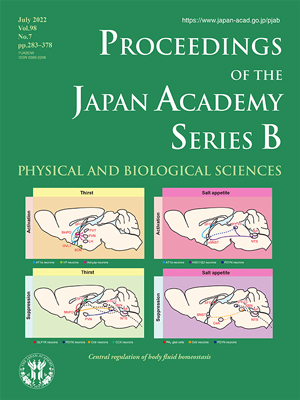About the Cover
Vol. 98 No. 7 (2022)
Animals that evolved from marine to terrestrial life hundreds of millions of years ago were at high risk of dehydration and hyponatremia because they could not easily consume water and salt on land. Therefore, body fluid homeostasis is vital to terrestrial animals including humans, in which body fluid osmolality is always strictly maintained at approximately 300 mOsm/kg. Because sodium ions (Na+) are a major electrolyte and the main determinant of osmolality of body (extracellular) fluids including blood and cerebrospinal fluid (CSF), body fluid homeostasis is almost equivalent to Na+ homeostasis. To maintain body fluid homeostasis, Na+ concentration ([Na+]) and osmolality are separately monitored in the body. When mice are deprived of water, for instance, they feel thirsty and seek water to drink, but they also avoid salt due to the elevation of [Na+] in blood and CSF during water deprivation. Simultaneously, the antidiuretic hormone vasopressin is secreted from the pituitary gland to reduce urine volume and save water. These behavioral and endocrine responses are governed by the subfornical organ (SFO) and organum vasculosum of the lamina terminalis (OVLT) in the brain. Because cells in these brain sites, devoid of a blood–brain barrier, monitor body fluid conditions, the SFO and OVLT are called sensory circumventricular organs (sCVOs). However, the mechanisms of body fluid monitoring and subsequent responses have long been unknown.
Noda and colleagues discovered [Na+] sensors specifically expressed in the sCVOs: Nax, a Na channel expressed in glial cells in the SFO and OVLT; and SLC9A4, a Na+/H+ exchanger expressed in OVLT neurons; both of which are activated by an increase in [Na+]. Their neurophysiological and molecular biological studies have provided compelling mechanisms for monitoring body fluid conditions by sensing [Na+] and angiotensin II. Furthermore, efferent mechanisms involving “water neurons” and “salt neurons” in the sCVOs have been shown to drive water and salt intake, respectively, together with relevant neural pathways (see the review article in this issue pp. 283–324). The activities of these driving neurons are rapidly suppressed by sensing water or salt intake in the oral cavity or digestive tract. Notably, Nax is involved in hypertension based on the [Na+] increase in body fluids caused by excess salt intake. The mechanism also involves Nax-expressing glial cells and gliotransmitters, lactate, epoxyeicosatrienoic acids, and H+, which activate specific neurons controlling salt intake, water intake, and sympathetic nervous system, respectively. The review by Noda and Matsuda summarizes advances in understanding the brain mechanisms for body fluid homeostasis over the past 20 years.
Kazuhiro Nakamura
Professor, Nagoya University Graduate School of Medicine




